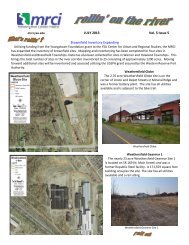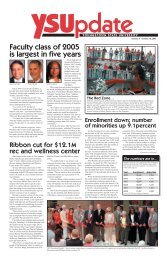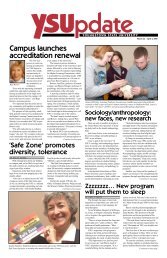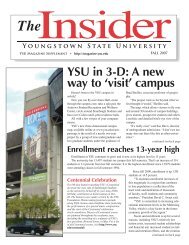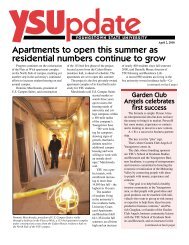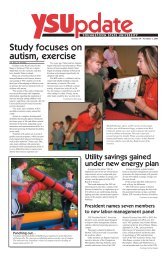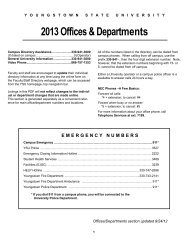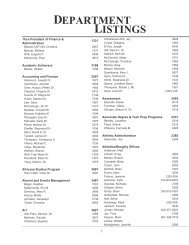N N IAL CEL O - Youngstown State University
N N IAL CEL O - Youngstown State University
N N IAL CEL O - Youngstown State University
You also want an ePaper? Increase the reach of your titles
YUMPU automatically turns print PDFs into web optimized ePapers that Google loves.
Our first<br />
years<br />
1908<br />
The YMCA<br />
in downtown<br />
<strong>Youngstown</strong><br />
offers its first<br />
college-level<br />
course in<br />
commercial<br />
law, with an<br />
evening class<br />
of nine men.<br />
1916<br />
The <strong>Youngstown</strong> Association<br />
School is incorporated. Both college<br />
and high school-level courses<br />
are still held at the YMCA.<br />
1920<br />
The Law School of the<br />
<strong>Youngstown</strong> Association School<br />
offers bachelor of law degrees for<br />
the first time.<br />
The School of Finance and<br />
Commerce is established.<br />
From a class of nine men in a commercial law course at the YMCA in downtown<br />
<strong>Youngstown</strong> to hundreds of classes filled with students as diverse as the community it’s<br />
located in, the 100-year history of <strong>Youngstown</strong> <strong>State</strong> <strong>University</strong> has been extraordinary.<br />
With more than 85,000 alumni in a variety of professions and places around the world,<br />
the university’s next 100 years promise to be as remarkable as the first.<br />
This timeline highlights notable events that brought YSU<br />
from nine students, one building and one degree to<br />
13,000 students, 50 buildings and more<br />
than 30 associate, bachelor,<br />
master and doctoral<br />
degrees.<br />
1925<br />
John C. Wick Mansion at the corner of<br />
Wick and Lincoln avenues is purchased<br />
as a classroom facility.<br />
1921<br />
The <strong>Youngstown</strong> Association<br />
School is renamed the <strong>Youngstown</strong><br />
Institute of Technology.<br />
The first liberal arts courses<br />
are offered for teacher<br />
preparation.<br />
1922<br />
The <strong>Youngstown</strong> Institute of<br />
Technology awards its first<br />
college degrees in law.<br />
The Bonnell Mansion on<br />
Wick Avenue is leased to<br />
house the collegiate division<br />
of the <strong>Youngstown</strong> Association<br />
School, the <strong>Youngstown</strong><br />
Institute of Technology. This<br />
is the first movement to Wick<br />
Avenue and out of the downtown<br />
area.<br />
1924<br />
<strong>Youngstown</strong> Institute of Technology<br />
is authorized by the <strong>State</strong> of<br />
Ohio to grant commercial (business)<br />
degrees.<br />
1927<br />
A day school is authorized by the<br />
YMCA Board of Trustees to offer<br />
liberal arts courses.<br />
Red and gold are selected as<br />
school colors.<br />
The athletic program begins<br />
with the creation of the school’s<br />
basketball team.<br />
1928<br />
The Henry Wick Mansion on 416<br />
Wick Avenue is leased for additional<br />
classroom space and later renamed<br />
East Hall.<br />
The institution’s<br />
first yearbook is<br />
published,<br />
Technician 1928.<br />
1930<br />
A music program<br />
begins.<br />
1931<br />
The Board of Trustees<br />
designates<br />
the college division of the YMCA<br />
as <strong>Youngstown</strong> College.<br />
<strong>Youngstown</strong> College’s Main Building,<br />
now Jones Hall, is completed.<br />
The Jambar student newspaper<br />
begins publication.<br />
1933<br />
The YoCo basketball<br />
team are called<br />
Penguins for the<br />
first time.<br />
<strong>Youngstown</strong><br />
College receives<br />
accreditation from<br />
the Ohio<br />
Department of<br />
Education to<br />
teach education<br />
courses.<br />
1935<br />
Howard W. Jones is appointed<br />
the first president of <strong>Youngstown</strong><br />
College.<br />
1936<br />
The college’s official seal is adopted.<br />
1937<br />
The Board of Governors officially<br />
incorporates<br />
<strong>Youngstown</strong><br />
College.<br />
1938<br />
<strong>Youngstown</strong><br />
College’s football<br />
team and marching<br />
band take to<br />
the field for the<br />
first time.<br />
1941<br />
Buechner Hall, a<br />
privately owned dormitory, opens<br />
its doors to female students.<br />
The Dana Musical<br />
Institute merges with<br />
<strong>Youngstown</strong> College.<br />
YoCo’s football<br />
coach, Dwight<br />
“Dike” Beede,<br />
invents the<br />
penalty flag.<br />
Pete,YoCo’s first<br />
live penguin mascot, drowns at<br />
Crandall Park. He is later succeeded<br />
by four other penguins, the last<br />
dying in 1972.<br />
1942<br />
<strong>Youngstown</strong> College begins offering<br />
accelerated degree programs as<br />
the United <strong>State</strong>s enters the Second<br />
World War.<br />
1944<br />
<strong>Youngstown</strong> College becomes<br />
independent of the YMCA to receive<br />
accreditation from the North Central<br />
Association.<br />
1945<br />
<strong>Youngstown</strong> College’s colors are<br />
changed to red and white.<br />
1946<br />
The Rayen School of Engineering<br />
is founded with classes held in the<br />
leased Rayen Hall.<br />
Post-war attendance begins to<br />
skyrocket due to benefits offered to<br />
veterans through the GI Bill.<br />
1949<br />
<strong>Youngstown</strong> Sheet and Tube presents<br />
a 10-ton boulder to the class of 1949.<br />
After paying $500 to have the rock<br />
moved, it is presented to the college<br />
as a gift<br />
and placed<br />
in front of<br />
Jones Hall,<br />
where it<br />
remains.<br />
1950<br />
The George<br />
W. Pollock<br />
house is<br />
donated to<br />
YoCo.<br />
1951<br />
The Ford Homestead on Wick<br />
Avenue is donated to YoCo by<br />
Judge John W. Ford and his sister,<br />
Josephine Ford Agler.<br />
1953<br />
The new <strong>Youngstown</strong> College Library<br />
opens, which is now Tod Hall.<br />
1955<br />
<strong>Youngstown</strong> College<br />
is renamed the<br />
<strong>Youngstown</strong><br />
<strong>University</strong>.<br />
1958<br />
The <strong>Youngstown</strong><br />
<strong>University</strong><br />
celebrates 50 years<br />
of higher education in<br />
the Mahoning Valley.<br />
1959<br />
A new science building opens, now<br />
part of Ward Beecher Science Hall.<br />
1960<br />
The School of Education is founded.<br />
1964<br />
A multi-million dollar campus<br />
expansion plan is made public.<br />
1966<br />
Kilcawley Student<br />
Center opens.<br />
President Jones<br />
retires after 35 years<br />
of service. Dr. Albert<br />
L. Pugsley is<br />
named president.<br />
The <strong>Youngstown</strong> Education<br />
Foundation, now<br />
the YSU Foundation, is<br />
founded. Howard W. Jones<br />
is named first president.<br />
1967<br />
<strong>Youngstown</strong> <strong>University</strong> becomes<br />
<strong>Youngstown</strong> <strong>State</strong> <strong>University</strong>, a public<br />
institution of higher education.<br />
The Kilcawley Rock receives its<br />
first coat of paint.<br />
30 <strong>Youngstown</strong> <strong>State</strong> <strong>University</strong><br />
Summer 2007 31<br />
A Proud Past A Promising Future A Proud Past A Promising Future A Proud Past A Promising Future A Proud Past A Promising F



